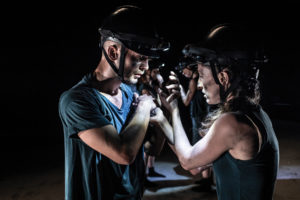Skånes Dansteater and Korea National Contemporary Dance Company: Fernando Melo, Hyerim Jang, Sungsoo Ahn / Mixed Bill - Vancouver Ballet Society
- Home
- Reviews 2014 - 2019
- Skånes Dansteater and Korea National Contemporary Dance Company: Fernando Melo, Hyerim Jang, Sungsoo Ahn / Mixed Bill

by MAGGIE FOYER
A program of cultural exchanges is in progress to celebrate 60 years of diplomatic relations between Sweden and South Korea. In Malmö, this resulted in a collaboration between Korea National Contemporary Dance Company and Skånes Dansteater, with exhilarating results. In a world increasingly torn apart by difference, this unity and celebration of other cultures is welcome.
Korea Connection was presented at Skånes Dansteater’s audience-friendly premises in the trendy docklands area. Two of the choreographers on the triple bill undertook “blind dates”: Sweden-based Brazilian choreographer Fernando Melo visited the Korean company in Seoul, and Korean choreographer Hyerim Jang journeyed to Malmö. Immixture, by Sungsoo Ahn, choreographing on the Korean company, which he directs, completed the bill.
In The Longest Distance Between Two Points, Melo follows a theme of separating, dividing and seeing things from a different perspective. It’s an idea he has exploited to excellent effect in earlier works. In Middle of Nowhere for Norrdans (2014), a screen divides the playing area into two, and in the recent Afterimage for the National Dance Company Wales, he uses Pepper’s ghost illusion, a magic sleight of hand involving mirrors.
In the present work for six Korean dancers, he used the physical barrier of planks of wood to explore our need for human contact. They proved versatile dance partners, hiding, supporting or even enclosing when one dancer is imprisoned in a four-square cell. Another time, it provided the means for a couple to play hide and seek.
Melo used the dexterity of the casually dressed dancers skilfully, whether it was manipulating the planks in a variety of choreographic devices or in their perfectly timed movements in canon. The stage was bare but for a pile of stacked wood, with austere, minimal lighting that brought a sense of detachment. By contrast, the one tender relationship that developed became a precious focal point in a work of high male energy.

Jang’s heartfelt Burnt Offering burrowed deep into the human psyche to express loss and collective struggle. Between phrases of powerful ensemble dance, she wove in personal testimonials as each dancer spoke the name of a lost loved one, then detached from the group to walk downstage and place a miner’s hard hat on the ground like a ritual offering.
Working with composer Youngjoo Lee, Jang takes a departure point from the rhythms of Seungmu, one of Korea’s most famous traditional dances, usually performed by Buddhist monks. The ritual essence found a different dynamic when it met the thrust of Western energy. The pulse was a driving force; it was pounded out by the feet, bolstered by swinging arms and, at times, by the group progressing in rocking motion on their knees. It became the workers’ rallying cry.
The group was dressed in muted blue shirts, shorts and socks. They wore traditional miners’ hard hats with their headlamps cutting through the darkness as an adjunct to the dramatic lighting by Tobias Hagström-Ståhl. Jang’s choreographic language was rich in meaning, extremely physical and skilfully structured. Part religious ritual, part contemporary protest, it was a riveting work that was given a performance of high intensity and commitment by the Skånes’ dancers.
The opening, all-Korean work, Immixture, began on a note of authenticity as a dancer, clothed in the traditional costume of crisp white linen, danced with cultural purity, specific in every delicate gesture and footfall. She was superseded by a contemporary dancer, who was soon joined by several more. Even in modern guise, these dancers never lost the plasticity and pliability in their arms, and glimpses of tradition returned in extended sleeves that became scarf-like appendages adding to the flow of the gestures.
Ahn’s choreography has the fluidity and release we recognize as part of Western vocabulary, but is distinctive in the beauty of line, shape and form, both unusual and appealing. In the West, contemporary choreographers seldom admire beauty for its own sake, but Korean women in society and in dance still face pressure to conform to ideals of feminine grace and beauty. However, over a decade of visits to Seoul International Dance Competition, I have noticed a greater acceptance of diversity in body shape and in accepting expressive movement over aesthetics, resulting in a vibrant and diverse contemporary dance scene.
The sole man in Immixture, Ilyoung Seo, was a mood changer, a K-pop icon with blond hair, tattoos and trendy headphones. He launched into a fiery display of street dance before stepping aside to let the quartet of women return to centre stage to a remix of classical music. The variety of styles, a not unhappy blend, made the work worthy of its title, but it seemed to have little to do with the “sorrowful requiem” of the program notes.
Creating something genuinely new is every artist’s dream, and bringing together dancers from cities 8,000 kilometres apart gave both companies a creative spur, provoking an exceptional evening of dance.
DI SUMMER 2019

